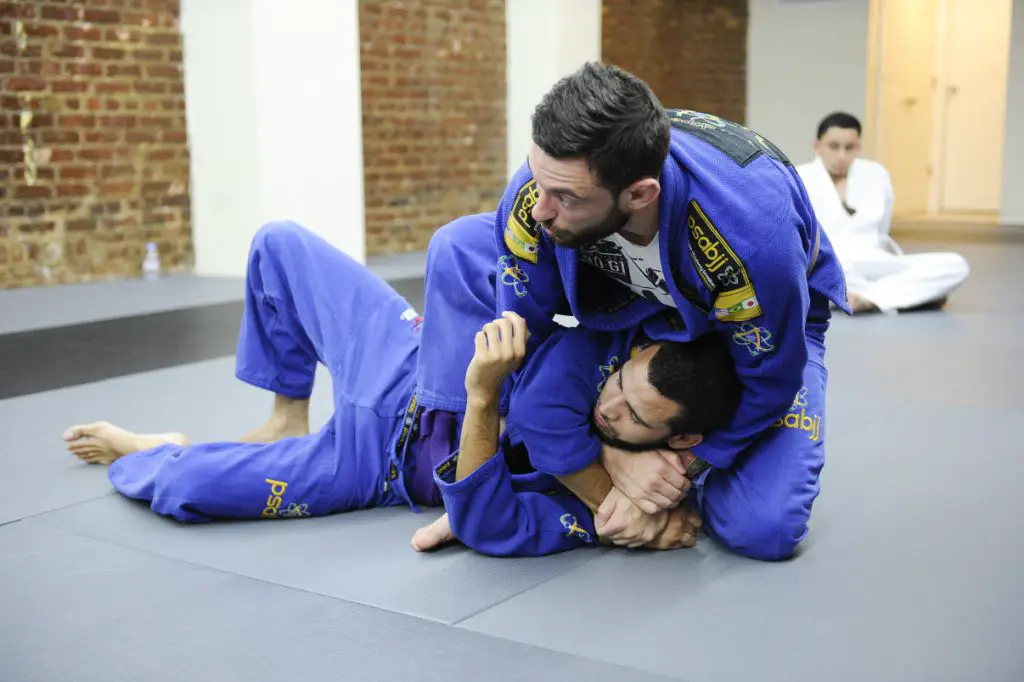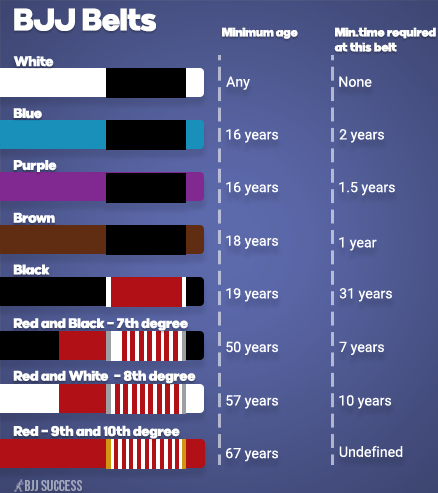
“There is no losing in jiu-jitsu. You either win or you learn.” – Carlos Gracie, Sr
Brazilian jiu-jitsu (BJJ) is a popular self-defense combat sport in martial arts. It uses techniques like grappling, ground fighting, and chokeholds that force the opponent to surrender. This makes a resourceful defense tactic for a smaller person against larger opponents, as the combined effect of speed and strength takes them by surprise.
Leverage principles, pressure, and good timing define the controlled, non-violent nature of this discipline. Without using any strikes or kicks, Brazilian jiu-jitsu applies the idea of close-contact defenses such as joint manipulations. The main theme is to first tackle the opponent to the ground since it is difficult to gain the upper hand while standing.
Origins of Brazilian jiu-jitsu
The term “jiu-Jitsu” means “gentle art” in Japanese. The Brazilian adaptation has its roots in the Japanese jiu-jitsu as well as judo. The style dates back to the early 1900s, although ancient ruins provide evidence of similar ground-based, non-violent combat from thousands of years ago.
When the legendary Japanese judoka Mitsuyo Maeda travelled to Brazil in 1915, he taught the art of jiu-jitsu and judo to his students, three of whom turned out to be the pioneers and founders of Brazilian jiu-jitsu. Two brothers – Carlos and Helio Gracie – and Luiz França joined forces in a powerful collaboration that went on to become a global phenomenon. They refined the existing disciplines, adapted their skills, and introduced new techniques. This led to the inception of Brazilian jiu-jitsu: a ground-based martial art that shook the continental ground and carried the wave across the world. An interesting fact is that many BJJ practitioners today are descendants of the three founders and can trace their lineages back to them!
The International Brazilian Jiu-Jitsu Federation (IBJJF) was founded by Carlos Gracie Jr. in 2002. Following its inauguration, the company has hosted several major tournaments and championships.
Benefits of Brazilian jiu-jitsu
1. Physical fitness
The BJJ discipline has a series of dynamic movements based on pressure. This adds a cardio element to the exercise to help you lose weight and tone muscles. Coordination, balance, and reactive skills develop progressively because you are always hyper-aware of your opponent’s moves. It is often described as playing a live game of human chess where you act as soon as you anticipate. Training with BJJ coaches is a productive way to enhance your agility, self-discipline, and athletic strengths.
2. Mental health
Brazilian jiu-jitsu makes a dual workout routine as it requires you to invest both your mental and physical strengths. The mental exercise comes with the challenge of practicing something new. This martial art is a fast-paced activity that demands spontaneous decision-making. Every moment requires you to plan your next move, so your reasoning ability is constantly tested. As you respond to the opponent, you also learn to stay calm and focused, especially in a defensive position. Jiu-jitsu leaves no room for distractions and calls for your undivided attention, which makes it a perfect escape from stress and anxiety.
3. Designed for everyone
The best part about Brazilian jiu-jitsu is that anyone and everyone can do it. The strategies and philosophies used allow smaller/weaker people to leverage their skills against stronger opponents. This helps with self-defense tactics that are empowering and reliable. Factors like age, physique, gender, and height do not matter at all.
4. Foundation for Mixed Martial Arts (MMA)
In most cases, Ultimate Fighting Championship (UFC) professionals have a black belt in Brazilian jiu-jitsu. The black belt is the highest expert level in BJJ martial art and gives MMA fighters a great defensive advantage over their opponent.
5. Transferable skills at the mat
BJJ martial artists follow various guidelines on the mat, like bowing formally and never wearing shoes. Personal hygiene is crucial, and your uniform should always be neat. The routines teach you self-respect as well as respect for peers. You walk out of the mat armed with defensive expertise and social traits that always count.
Why Brazilian jiu-jitsu is a great hobby
There are several reasons why people enjoy Brazilian jiu-jitsu as a hobby – and why you should add it to your new year’s resolution if you love martial arts.
Attending BJJ classes is an exciting way to meet new people and thrive among cultural diversities and lifelong friendships. The jiu-jitsu learning curve itself helps you build confidence and overcome personal obstacles along the way. Growth and progress require you to change and adapt to new circumstances, and this means stepping out of your comfort zones. Learning this versatile martial arts discipline encourages you to be brave and embrace challenges. Furthermore, it is a much safer option than striking martial arts, and definitely more thrilling than simply working out at the gym.
Brazilian jiu-jitsu belts
Adult belts
The International Brazilian Jiu-Jitsu Federation (IBJJF) has set its standard belt graduation system. Age and experience determine belt promotions, which are implemented throughout the world. IBJJF belts are awarded considering the practitioners’ skills and the total time that they have spent in training so far.

Arranged from the lowest to the highest ranks, the adult BJJ belts are:
- White Belt
- Blue Belt
- Purple Belt
- Brown Belt
- Black Belt
- Red and Black Belt (Coral Belt)
- Red and White Belt (Coral Belt)
- Red Belt
The white belt is your first beginner step into the Brazilian jiu-jitsu journey, and it is where you warm up to fundamental defense techniques. Blue belt students can apply their skills in real life and have a formative learning curve ahead. The purple belt signifies experience in all the core jiu-jitsu positions and proves commitment to the art of Brazilian jiu-jitsu. Students who build upon their purple-belt aptitude, accomplish defensive strategies, and consolidate all the skills from the previous belts are the ones who claim the elite level of a brown belt. Finally, the black belt marks a huge milestone achievement as it is, essentially, the finishing line of your journey. Black belt students develop ambitious combative strengths – both at the mat and in real life – and are recognized for their grappling prowess.
Starting from Day 1 at your BJJ academy, it takes around 10 years of unyielding determination to become a black-belt practitioner. One groundbreaking exception was when BJ Penn, the first American World Jiu Jitsu champion, earned the fastest black-belt promotion in just 3 years and 4 months!
Beyond the black belt
BJJ martial artists who choose to pursue even higher ranks to elevate their black-belt status work towards degrees or grades of the belt. Post-black-belt pursuits open teaching opportunities as well, and these allow students to aim for instructor certifications. Each grade from 1 to 10 requires the practitioner to maintain the status for a significant number of years before progressing towards the coral belts. These coral belts are represented as white bars on the black belt. At long last – which is 48 years after the black belt – a BJJ stands with a red belt at the summit of this rocky climb. Red belts earn the title of grandmasters.
According to the IBJJF graduation rules, practitioners are required to meet the experience criteria at each belt by completing the stated duration. This makes them eligible for belt promotion. Practitioners should also adhere to IBJJF age requirements. They must be at least 16 years old for blue and purple belts, at least 18 years old for brown, and at least 19 for black belt.
Juvenile BJJ
A separate IBJJF kids belt system addresses age requirements for children between the ages of 4 to 15. Juvenile programs allow kids to discover their martial art streak from a young age. Having more belts to win gives children a sense of accomplishment and motivates them to aim higher. Arranged from the lowest to the highest ranks, the kids’ belts are:
- White
- Gray-White
- Gray
- Gray-Black
- Yellow-White
- Yellow
- Yellow-Black
- Orange-White
- Orange
- Orange-Black
- Green-White
- Green
- Green-Black
“If you ask me what belt I am today I’ll tell you that I’m a white belt that never gave up.”
– Jean Jacques Machado
